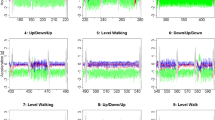Abstract
Human activity recognition using wearable sensors and classification methods provides valuable information for the assessment of user’s physical activity levels and for the development of more precise energy expenditure models, which can be used to proactively prevent cardiovascular diseases and obesity. The aim of this study was to evaluate how maritime environment and sea waves affect the performance of modern physical activity recognition methods, which has not yet been investigated. Two similar test suits were conducted on land and on a small yacht where subjects performed various activities, which were grouped into five different activity types of static, transitions, walking, running and jumping. Average activity type classification sensitivity with a decision tree classifier trained using land-based signals from one tri-axial accelerometer placed on lower back and leave-one-subject-out cross-validation scheme was 0.95 ± 0.01 while classifying the activities performed on land, but decreased to 0.81 ± 0.17 while classifying the activities on sea. An additional component produced by sea waves with a frequency of 0.3–0.8 Hz and a peak-to-peak amplitude of 2 m/s2 was noted in sea-based signals. Additional filtration methods were developed with the aim to remove the effect of sea waves using the least amount of computational power in order to create a suitable solution for real-time activity classification. The results of this study can be used to develop more precise physical activity classification methods in maritime areas or other locations where background affects the accelerometer signals.
Access this chapter
Tax calculation will be finalised at checkout
Purchases are for personal use only
Similar content being viewed by others
References
Altini, M., Penders, J., Vullers, R., Amft, O.: Estimating Energy Expenditure Using Body-Worn Accelerometers: A Comparison of Methods, Sensors Number and Positioning. IEEE Journal of Biomedical and Health Informatics 19 (1), 219–226 (2015).
Awais, M., Mellone, S., Chiari, L.: Physical activity classification meets daily life: Review on existing methodologies and open challenges. In: Proceedings of the 37th Annual International Conference of the IEEE Engineering in Medicine and Biology Society (EMBC), IEEE, Milan, Italy, pp. 5050–5053 (2015).
Lu, Y., Wei, Y., Liu, L., Zhong, J., Sun, L., Liu, Y. Towards unsupervised physical activity recognition using smartphone accelerometers. Multimedia Tools and Applications 76 (8), 10701–10719 (2017).
Weiss, G. M., Timko, J. L., Gallagher, C. M., Yoneda, K., Schreiber, A. J.: Smartwatch-based Activity Recognition: A Machine Learning Approach. In: Proceedings of the IEEE-EMBS International Conference on Biomedical and Health Informatics, IEEE, Las Vegas, USA, pp. 426–429 (2016).
Altini, M., Penders, J., Vullers, R.: Combining wearable accelerometer and physiological data for activity and energy expenditure estimation. In: Proceedings of the 4th Conference on Wireless Health, ACM New York, Baltimore, USA (2013).
Curone, D., Tognetti, A., Secco, E. L., Anania, G., Carbonaro, N., De Rossi, D., Magenes, G.: Heart Rate and Accelerometer Data Fusion for Activity Assessment of Rescuers During Emergency Interventions. IEEE Transactions on Information Technology in Biomedicine 14 (3), 702–710 (2010).
Moncada-Torres, A., Leuenberger, K., Gonzenbach, R., Luft, A., Gassert, R.: Activity classification based on inertial and barometric pressure sensors at different anatomical locations. Physiological Measurement 35 (7), 1245–1263 (2014).
Wang, J., Redmond, S. J., Voleno, M., Narayanan, M. R., Wang, N., Cerutti, S., Lovell, N. H.: Energy expenditure estimation during normal ambulation using triaxial accelerometry and barometric pressure. Physiological Measurement 33 (11), 1811–1830 (2012).
Tapia, E. M.: Using Machine Learning for Real-time Activity Recognition and Estimation of Energy Expenditure. PhD Thesis, Massachusetts Institute of Technology (2008).
Altun, K., Barshan, B., Tuncel, O.: Comparative study on classifying human activities with miniature inertial and magnetic sensors. Pattern Recognition 43 (10), 3605–3620 (2010).
Allik, A., Pilt, K., Karai, D., Fridolin, I., Leier, M., Jervan, G.: Activity Classification for Real-time Wearable Systems: Effect of Window Length, Sampling Frequency and Number of Features on Classifier Performance. In: Proceedings of the IEEE-EMBS Conference on Biomedical Engineering and Sciences, IEEE, Kuala Lumpur, Malaysia, pp. 460–464 (2016).
Powers, D. M. W.: Evaluation: from precision, recall and F-factor to ROC, informedness, markedness and correlation. Journal of Machine Learning Technologies 2 (1), 37–63 (2011).
Author information
Authors and Affiliations
Corresponding author
Editor information
Editors and Affiliations
Rights and permissions
Copyright information
© 2019 Springer Nature Singapore Pte Ltd.
About this paper
Cite this paper
Allik, A., Pilt, K., Karai, D., Fridolin, I., Leier, M., Jervan, G. (2019). Classification Algorithm Improvement for Physical Activity Recognition in Maritime Environments. In: Lhotska, L., Sukupova, L., Lacković, I., Ibbott, G. (eds) World Congress on Medical Physics and Biomedical Engineering 2018. IFMBE Proceedings, vol 68/3. Springer, Singapore. https://doi.org/10.1007/978-981-10-9023-3_3
Download citation
DOI: https://doi.org/10.1007/978-981-10-9023-3_3
Published:
Publisher Name: Springer, Singapore
Print ISBN: 978-981-10-9022-6
Online ISBN: 978-981-10-9023-3
eBook Packages: EngineeringEngineering (R0)




